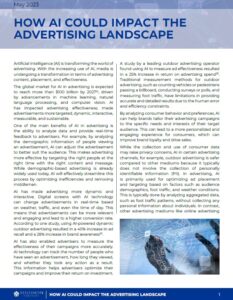How AI Could Impact the Advertising Landscape
 How AI Could Impact the Advertising Landscape
How AI Could Impact the Advertising Landscape
Artificial Intelligence (AI) is transforming the world of advertising. With the increasing use of AI, media is undergoing a transformation in terms of advertising content, placement, and effectiveness.
The global market for AI in advertising is expected to reach more than $100 billion by 2027, driven by advancements in machine learning, natural language processing, and computer vision. AI has impacted advertising effectiveness; made advertisements more targeted, dynamic, interactive, measurable, and sustainable. One of the main benefits of AI in advertising is the ability to analyze data and provide real-time feedback to advertisers. For example, by analyzing the demographic information of people viewing an advertisement, AI can adjust the advertisement to better suit the audience. This makes advertising more effective by targeting the right people at the right time with the right content and message. While demographic-based advertising is already widely used today, AI will effectively streamline this process by optimizing inefficiencies and removing middlemen.
AI has made advertising more dynamic and interactive. Digital screens with AI technology can change advertisements in real-time based on weather, traffic, and even the time of day. This means that advertisements can be more relevant and engaging and lead to a higher conversion rate. According to one study, using AI-powered dynamic outdoor advertising resulted in a 40% increase in ad recall and a 28% increase in brand awareness.
AI has also enabled advertisers to measure the effectiveness of their campaigns more accurately. AI technology can track the number of people who have seen an advertisement, how long they viewed, and whether they took any action as a result. This information helps advertisers optimize their campaigns and improve their return on investment.
A study by a leading outdoor advertising operator found using AI to measure ad effectiveness resulted in a 25% increase in return on advertising spend. Traditional measurement methods for outdoor advertising, such as counting vehicles or pedestrians passing a billboard, conducting surveys or polls, and measuring foot traffic, have limitations in providing accurate and detailed results due to the human error and efficiency constraints.
By analyzing consumer behavior and preferences, AI can help brands tailor their advertising campaigns to the specific needs and interests of their target audience. This can lead to a more personalized and engaging experience for consumers, which can improve brand loyalty and drive sales.
While the collection and use of consumer data may raise privacy concerns, AI in certain advertising channels, for example, outdoor advertising is safer compared to other mediums because it typically does not involve the collection of personally identifiable information (PII). In advertising, AI is primarily used for optimizing ad placement and targeting based on factors such as audience demographics, foot traffic, and weather conditions. This is typically done by analyzing aggregated data, such as foot traffic patterns, without collecting any personal information about individuals. In contrast, other advertising mediums like online advertising and social media platforms collect a large amount of PII from users, including browsing history, personal preferences, and location data. This information can be used to target ads to specific individuals, which has raised concerns about racking, privacy rights, data collection, and other issues with limited regulations. Advertisers need to be transparent about their data collection practices and ensure that they comply with relevant privacy laws and regulations. We expect this environment to grow increasingly more regulated, limiting the hypertargeting data that the online advertising industry has leveraged to grow its share of the marketing mix in the last two decades.
Technology has undoubtedly advanced advertising, transforming its development and execution by providing advertisers with indispensable tools for creating captivating campaigns and targeting the right audience. AI has the potential to further revolutionize advertising and media by making it more targeted, dynamic, interactive, measurable, and sustainable. However, as with the rapid outgrowth (and subsequent pullback) of data collection practices in digital advertising, advertisers must be cognizant of the potential concerns associated with AI’s role in advertising. Advertisers especially must take steps to ensure they are collecting and using consumer data in a responsible and transparent manner. As AI technology continues to evolve, advertising is likely to become even more sophisticated and effective and provide brands with new and innovative ways to reach consumers.
Click below to read the article from the Media Group.





